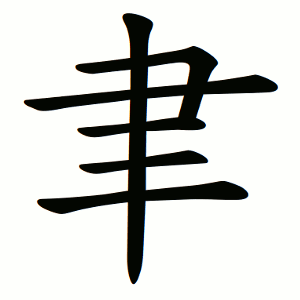聿
- writing brush, paint brush;
Etymology
It was created by modeling the shape of a hand holding a brush. The part in the middle that looks like 彐 represents the hand, and the remaining part that looks like a 十 represents the brush.
Originally, the shape should have been something like 𦘒, but a horizontal stroke 一 (one) was added at the bottom, forming the current shape.
According to the Shuowen Jiezi (説文解字 shuōwén jiězì), 聿 is a phono-semantic compound: it takes the meaning from 𦘒 and the sound from 一.
Later, when the bamboo radical 竹 (bamboo) was added, the character 筆 (brush) was formed, which specifically means "writing brush."
Usage in Korean
When used as a radical, it generally indicates meanings related to brushes or writing instruments.
Even though 聿 appears as a component in some characters, the original source may not be related to 聿 itself. For example:
1. In 津, the 聿 part was originally 𦘔 (meaning "to decorate with a brush," ⿹聿彡), which later simplified to 聿.
2. In 肆, 聿 is actually a simplification of 隶, unrelated to 聿.
- 中手 (LQ)
- ⿻ 肀 二
- ⿻ 𦘒 一
